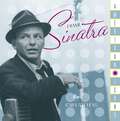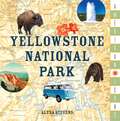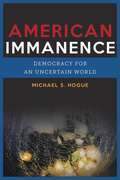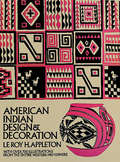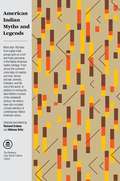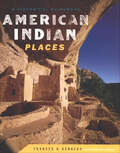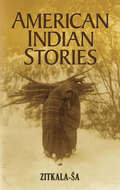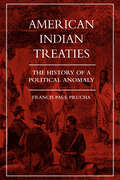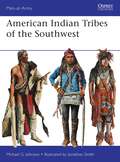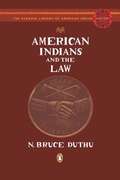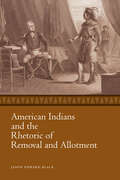- Table View
- List View
American Icons: Frank Sinatra
by Stonesong PressThe American Icons series celebrates the people, places, and objects that have informed American popular culture over the last 75 years. Illustrated throughout and replete with anecdotes, fun facts, and informative sidebars.American Icons: Frank Sinatra celebrates the legendary crooner who defined American music, class, and style for a generations. From his early years during the swing era to his solo career and time with the famous Rat Pack, this book explores the colorful, exciting life of Ol' Blue Eyes.
American Icons: Yellowstone National Park
by Stonesong PressThe American Icons series celebrates the people, places, and objects that have informed American popular culture over the last 75 years. Illustrated throughout and replete with anecdotes, fun facts, and informative sidebars.American Icons: Yellowstone National Park is a celebration of America's first national park. From its famous geothermal geysers to its abundant wildlife, Yellowstone National Park is arguably the most beautiful land in North America, and this book captures that splendor by exploring the park's history and place in American pop culture.
American Immanence: Democracy for an Uncertain World (Insurrections: Critical Studies in Religion, Politics, and Culture)
by Michael S. HogueThe Anthropocene marks the age of significant human impact on the Earth’s ecosystems, dramatically underscoring the reality that human life is not separate from nature but an integral part of it. Culturally, ecologically, and socially destructive practices such as resource extraction have led to this moment of peril. These practices, however, implicate more than industrial and economic systems: they are built into the political theology of American exceptionalism, compelling us to reimagine human social and political life on Earth. American Immanence seeks to replace the dominant American political tradition, which has resulted in global social, economic, and environmental injustices, with a new form of political theology, its dominant feature a radical democratic politics. Michael S. Hogue explores the potential of a dissenting immanental tradition in American religion based on philosophical traditions of naturalism, process thought, and pragmatism. By integrating systems theory and concepts of vulnerability and resilience into the lineages of American immanence, he articulates a political theology committed to democracy as an emancipatory and equitable way of life. Rather than seeking to redeem or be redeemed, Hogue argues that the vulnerability of life in the Anthropocene calls us to build radically democratic communities of responsibility, resistance, and resilience. American Immanence integrates an immanental theology of, by, and for the planet with a radical democratic politics of, by, and for the people.
American Immigrant: My Life in Three Languages
by Rosalie PorterImmigration is one of the most contentious issues in twenty-first-century America. In forty years, the American population has doubled from 150 to 300 million, about half of the increase due to immigration. Discussions involving legal and illegal status, assimilation or separatism, and language unity or multilingualism continue to spark debate. The battle to give five million immigrant children America's common language, English, and to help these students join their English-speaking classmates in opportunities for self-fulfillment continues to be argued. American Immigrant is part memoir and part account of Rosalie Pedalino Porter's professional activities as a national authority on immigrant education and bilingualism.Her career began in the 1970s, when she entered the most controversial arena in public education, bilingualism. This book chronicles the political movement Porter helped lead, one that succeeded in changing state laws in California, Arizona, and Massachusetts. Programs that had segregated Latino children by language and ethnicity for years, diminishing their educational opportunities, were removed with overwhelming public support. New English-language programs in these states are reporting improved academic achievement for these students.This book is also Porter's testament to the boundless opportunities for women in the United States, and to the unique blending of ethnicities and religions and races into harmonious families, her own included, that continues to be a true strength of the United States Porter examines women's roles, beginning in the 1940s and continuing through the millennium, from the vantage point of someone who grew up in a working-class, male-dominated family. She explores the emotional price exacted by dislocation from one's native land and traditions; traveling and living in the Middle East, Europe, and Asia; and the evolving character of marriage and family in twenty-first-century America.
American Immigration Today: Pressures, Problems, Policies
by Judith BentleyDiscusses patterns of immigration into the United States and the ethical, political, and economic issues related to American immigration laws and policies.
American Immigration: Our History, Our Stories
by Kathleen KrullAward-winning author Kathleen Krull takes an in-depth historical look at immigration in America—with remarkable stories of some of the immigrants who helped build this country. With its rich historical text, fascinating sidebars about many immigrants throughout time, an extensive source list and timeline, as well as captivating photos, American Immigration will become a go-to resource for every child, teacher, and librarian discussing the complex history of immigration.America is a nation of immigrants. People have come to the United States from around the world seeking a better life and more opportunities, and our country would not be what it is today without their contributions. From writers like Chimamanda Ngozi Adichie, to scientists like Albert Einstein, to innovators like Elon Musk, this book honors the immigrants who have changed the way we think, eat, and live. Their stories serve as powerful reminders of the progress we’ve made, and the work that is still left to be done.
American Imperial Pastoral: The Architecture of US Colonialism in the Philippines
by Rebecca Tinio MckennaIn 1904, renowned architect Daniel Burnham, the Progressive Era urban planner who famously “Made No Little Plans,” set off for the Philippines, the new US colonial acquisition. Charged with designing environments for the occupation government, Burnham set out to convey the ambitions and the dominance of the regime, drawing on neo-classical formalism for the Pacific colony. The spaces he created, most notably in the summer capital of Baguio, gave physical form to American rule and its contradictions. In American Imperial Pastoral, Rebecca Tinio McKenna examines the design, construction, and use of Baguio, making visible the physical shape, labor, and sustaining practices of the US’s new empire—especially the dispossessions that underwrote market expansion. In the process, she demonstrates how colonialists conducted market-making through state-building and vice-versa. Where much has been made of the racial dynamics of US colonialism in the region, McKenna emphasizes capitalist practices and design ideals—giving us a fresh and nuanced understanding of the American occupation of the Philippines.
American Imperialist: Cruelty and Consequence in the Scramble for Africa
by Arwen P. MohunThis biography of “African explorer” Richard Dorsey Mohun, written by one of his descendants, reveals how American greed and state power helped shape the new imperial order in Africa. Richard Dorsey Mohun spent his career circulating among the eastern United States, the cities and courts of Europe, and the African continent, as he served the US State Department at some points and King Leopold of Belgium at others. A freelance imperialist, he implemented the schemes of American investors and the Congo Free State alike. Without men like him, Africa’s history might have unfolded very differently. How did an ordinary son of a Washington bookseller become the agent of American corporate greed and European imperial ambition? Why did he choose to act in ways that ranged from thoughtless and amoral to criminal and unforgivable? With unblinking clarity and precision, historian Arwen P. Mohun interrogates the life and actions of her great-grandfather in American Imperialist. She seeks not to excuse the man known as Dorsey but to understand how individual ambition and imperial lust fueled each other, to catastrophic ends. Ultimately, she offers a nuanced portrait of how her great-grandfather’s pursuit of career success and financial security for his family came at a tragic cost to countless Africans.
American Independent Inventors in an Era of Corporate R&D (Lemelson Center Studies in Invention and Innovation series)
by Eric S. HintzHow America's individual inventors persisted alongside corporate R&D labs as an important source of inventions.During the nineteenth century, heroic individual inventors such as Thomas Edison and Alexander Graham Bell created entirely new industries while achieving widespread fame. However, by 1927, a New York Times editorial suggested that teams of corporate scientists at General Electric, AT&T, and DuPont had replaced the solitary "garret inventor" as the wellspring of invention. But these inventors never disappeared. In this book, Eric Hintz argues that lesser-known inventors such as Chester Carlson (Xerox photocopier), Samuel Ruben (Duracell batteries), and Earl Tupper (Tupperware) continued to develop important technologies throughout the twentieth century. Moreover, Hintz explains how independent inventors gradually fell from public view as corporate brands increasingly became associated with high-tech innovation.Focusing on the years from 1890 to 1950, Hintz documents how American independent inventors competed (and sometimes partnered) with their corporate rivals, adopted a variety of flexible commercialization strategies, established a series of short-lived professional groups, lobbied for fairer patent laws, and mobilized for two world wars. After 1950, the experiences of independent inventors generally mirrored the patterns of their predecessors, and they continued to be overshadowed during corporate R&D's postwar golden age. The independents enjoyed a resurgence, however, at the turn of the twenty-first century, as Apple's Steve Jobs and Shark Tank's Lori Greiner heralded a new generation of heroic inventor-entrepreneurs. By recovering the stories of a group once considered extinct, Hintz shows that independent inventors have long been—and remain—an important source of new technologies.
American Indian / First Nations Schooling
by Charles L. GlennTracing the history of Native American schooling in North America, this book emphasizes factors in society at large - and sometimes within indigenous communities - which led to Native American children being separate from the white majority. Charles L. Glenn examines the evolving assumptions about race and culture as applied to schooling, the reactions of parents and tribal leadership in the United States and Canada, and the symbolic as well as practical role of indigenous languages and of efforts to maintain them.
American Indian Design and Decoration
by Le Roy AppletonThe most original and most powerful design art produced in the Western Hemisphere is also its most indigenous: that of the Indian, in innumerable cultures existing from prehistory to the arrival of the white man, reaching from the Arctic Circle to Tierra del Fuego. It owes, of course, nothing to Europe or the classical Orient. It is tremendous in variety, differing region by region, era by era, often tribe by tribe. It is always vigorously distinctive. This book, 20 years in preparation, shows us that art in all its profuse diversity and in the almost numberless crafts for which the American Indian is famous. Well over 700 examples, drawn with painstaking care, are shown: representations of flora and fauna, men and gods, earth and sky; symbols of clan and tribe, religion and magic; formal designs from the primal to the highly intricate. They appear in examples of basketry, weaving, pottery, sculpture, painting, lapidary work, masks, drumheads, weapons, apparel, beadwork, goldwork, blankets, ponchos, and many other forms. The arts and crafts of Inca, Tiahuanaco, Chimú, Maya, Axtec, Zapotec, Totonac, Mixtec, Navaho, Zuni, Hopi, Apache, Cherokee, Creek, Winnebago, Dakota, Blackfoot, Nez Percé, Cheyenne, Crow, Sioux, Cochiti, Haida, Bellacoola, and others known and unknown are here. Each section is preceded by a page of typical motifs of an area, making it easy to isolate the design elements. In addition, the lore and tradition behind the designs are told in a text reproducing the Indians' own stories and songs. Separate indices simplify locating the work of particular tribes and regions. Craftspeople will find in this book a prolific source of timeless, eternally valid design ideas representing years of research in museums all over the hemisphere; for the graphic artist there is a wealth of material than can be adapted directly to his needs. All those interested in the Americans who preceded us on these continents will find this work unique.
American Indian Health: Innovations in Health Care, Promotion, and Policy
by Everett R. RhoadesDisease processes among American Indians and Alaska Natives often have distinct manifestations that need to be considered by clinicians and health policy makers involved with these populations. Equally important, all aspects of Indian life—including health—are governed by the special relationship between Indian tribes and the U.S. federal government. For American Indian Health, Everett R. Rhoades has gathered a distinguished group of scholars and practitioners to present a comprehensive assessment of the health of American Indian peoples today and the delivery of health services to them.
American Indian Myths and Legends
by Richard Erdoes Alfonso OrtizGathering 160 tales from 80 tribal groups to offer a rich and lively panorama of the Native American mythic heritage. 100 drawings.
American Indian Places: A Historical Guidebook
by Frances H. KennedyThis historical guidebook includes 366 places that are significant to American Indians and open to the public. The book is organized geographically and includes location information, maps, and color photographs as well as suggestions for further reading about the sites and an extensive bibliography.Among the 279 authorities who know and revere these places and have written essays on them and on topics relating to them are William deBuys, Suzan Shown Harjo, Frederick E. Hoxie, Clara Sue Kidwell, Malinda Maynor Lowery, Rennard Strickland, and David Hurst Thomas. Tribal culture committees and tribal historians also contributed essays. Frances H. Kennedy, the editor and principal contributor, has written short entries on more than a hundred of the places.The places covered in the book include: Ganondagan State Historic Site in New York Kituhwa Mound in North Carolina, Cahokia Mounds State Historic Site in Illinois, Crystal River Archaeological State Park in Florida, Effigy Mounds National Monument in Iowa, Devils Tower National Monument in Wyoming, Chaco Culture National Historical Park in New Mexico, Navajo National Monument in Arizona, Olompali State Historic Park in California, La Purisima Mission State Historic Park in California, Nez Perce National Historical Park in Idaho.
American Indian Policy and American Reform: Case Studies of the Campaign to Assimilate the American Indians (Routledge Revivals)
by Christine BoltFirst published in 1987, American Indian Policy and American Reform examines key aspects of American Indian policy and reform in the context of American ethnic problems and traditions of reform. The first four chapters provide a chronological survey discussing racial attitudes, economic issues, the role of the Bureau of Indian Affairs, missionary and reformer involvement with government policy, the political interaction of Indians and whites, and other continuing differences between the two races. The second part of the book examines important themes which illuminate the difficulties of the assimilation campaign. In a series of case studies, Prof. Bolt explores Indian-black-white relations in the South and Indian Territory, American anthropologists and American Indians, Indian education from colonial times to the 20th century, Indian women, urban Indians since the Second World War and Indian political protest groups. This book will be of interest to students of American history, ‘minority’ history and race relations.
American Indian Policy in the Twentieth Century
by Vine Deloria Jr.A paperback reprint of the important collection of essays on federal Indian policy originally published in 1985 by the U. of Oklahoma Press.
American Indian Politics and the American Political System (2nd edition)
by David E. WilkinsIn this college textbook, Wilkins (American Indian studies, political science, law, and American studies, U. of Minnesota) considers the relationship of American Indian governments to the American political system with emphasis on the sovereignty of tribal nations. He analyzes the status of indigenous peoples and their citizenship, the concept of tribal sovereignty and the issues policymakers have, and their relationship with the government's branches. He provides an overview of federal Indian policy in history, descriptions of tribal governments, political economy and gaming, participation, interest-group activities and social activism, and the effect of the media. This edition integrates new census data; discussions of changes to elections, US House and Senate personnel, and legislation on Indian rights and the state-tribal relationship; and information on George W. Bush's terms in office. Annotation ©2006 Book News, Inc., Portland, OR (booknews.com)
American Indian Stories (Modern Library Torchbearers)
by Zitkala-SaA groundbreaking Dakota author and activist chronicles her refusal to assimilate into nineteenth-century white society and her mission to preserve her culture—with an introduction by Layli Long Soldier, winner of the National Book Critics Circle Award and the PEN/Jean Stein Book Award for Whereas Bright and carefree, Zitkála-Šá grows up on the Yankton Sioux reservation in South Dakota with her mother until Quaker missionaries arrive, offering the reservation’s children a free education. The catch: They must leave their parents behind and travel to Indiana. Curious about the world beyond the reservation, Zitkála-Šá begs her mother to let her go—and her mother, aware of the advantages that an education offers, reluctantly agrees. But the missionary school is not the adventure that Zitkála-Šá expected: The school is a strict one, her long hair is cut short, and only English is spoken. She encounters racism and ridicule. Slowly, Zitkála-Šá adapts to her environment—excelling at her studies, winning prizes for essay-writing and oration. But the price of success is estrangement from her cultural roots—and is it one she is willing to pay? Combining Zitkála-Šá’s childhood memories, her short stories, and her poetry, American Indian Stories is the origin story of an activist in the making, a remarkable woman whose extraordinary career deserves wider recognition.The Modern Library Torchbearers series features women who wrote on their own terms, with boldness, creativity, and a spirit of resistance.
American Indian Stories (Native American)
by Zitkala-SaBorn on South Dakota's Yankton Reservation in 1876, Zitkala-Sa felt "as free as the wind that blew my hair, and no less spirited than a bounding deer." At the age of 8, she traded her freedom for the iron discipline of a Quaker boarding school. Forever afterward, the Lakota Sioux author struggled to find a balance between Indian and white society. These autobiographical essays, short stories, and political writings offer her poignant reflections on being stranded between two worlds. Zitkala-Sa, who attended and taught at the Carlisle Indian Industrial School in Pennsylvania, was a founder of the National Council of American Indians and among the first Native Americans to record tribal legends and oral traditions. This collection opens with her reminiscences of the reservation, her schooling at an institution determined to "civilize" Indians, and her experiences as a teacher. Zitkala-Sa also recounts tales rooted in Sioux traditions, including "A Warrior's Daughter," in which a courageous woman risks everything for her husband-to-be; "The Trial Path," an account of tribal justice after a murder; and "The Sioux," in which a son must kill twice to save his father from starvation. The book concludes with incisive observations on government mistreatment of Indians and a call for the complete enfranchisement of Native Americans into mainstream society.
American Indian Treaties: The History of a Political Anomaly
by Francis Paul PruchaAmerican Indian affairs are much in the public mind today—hotly contested debates over such issues as Indian fishing rights, land claims, and reservation gambling hold our attention. While the unique legal status of American Indians rests on the historical treaty relationship between Indian tribes and the federal government, until now there has been no comprehensive history of these treaties and their role in American life.Francis Paul Prucha, a leading authority on the history of American Indian affairs, argues that the treaties were a political anomaly from the very beginning. The term "treaty" implies a contract between sovereign independent nations, yet Indians were always in a position of inequality and dependence as negotiators, a fact that complicates their current attempts to regain their rights and tribal sovereignty.Prucha's impeccably researched book, based on a close analysis of every treaty, makes possible a thorough understanding of a legal dilemma whose legacy is so palpably felt today.
American Indian Tribal Governments
by Sharon O'BrienThis book describes the struggle of Indian tribes and their governments to achieve freedom and self-determination despite repeated attempts by foreign governments to dominate, exterminate, or assimilate them. Drawing on the disciplines of political science, history, law, and anthropology and written in a direct, readable style, American Indian Tribal Governments is a comprehensive introduction to traditional tribal governments, to the history of Indian-white relations, to the structure and legal rights of modern tribal governments, and to the changing roles of federal and state governments in relation to modem tribal governments. Publication of this book fills a gap in American Indian studies, providing scholars with a basis from which to begin an integrated study of tribal government, providing teachers with an excellent introductory textbook, and providing general readers with an accessible and complete introduction to American Indian history and government. The book's unique structure allows coverage of a great breadth of information while avoiding the common mistake of generalizing about all tribes and cultures. An introductory section presents the basic themes of the book and describes the traditional governments of five tribes chosen for their geographic and cultural diversity-the Senecas, the Muscogees, the Lakotas, the Isleta Pueblo, and the Yakimas. The next three chapters review the history of Indian-white relations from the time Christopher Columbus "discovered" America to the present. Then the history and modem government of each of the five tribes presented earlier is examined in detail. The final chapters analyze the evolution and current legal powers of tribal governments, the tribal-federal relationship, and the tribal-state relationship. American Indian Tribal Governments illuminates issues of tribal sovereignty and shows how tribes are protecting and expanding their control of tribal membership, legal systems, child welfare, land and resource use, hunting and fishing, business regulation, education, and social services. Other examples show tribes negotiating with state and federal governments to alleviate sources of conflict, including issues of criminal and civil jurisdiction, taxation, hunting and fishing rights, and control of natural resources. Excerpts from historical and modem documents and speeches highlight the text, and more than one hundred photos, maps, and charts show tribal life, government, and interaction with white society as it was and is. Included as well are a glossary and a chronology of important events.
American Indian Tribes of the Southwest
by Michael Johnson Jonathan SmithThis book continues Osprey's series of Men-at-Arms titles on the history, costume, and material culture of the native peoples of North America, which is organized into geographical regions, language groups, and tribes. It was in the Southwest - modern Arizona, New Mexico, and parts of California and other neighboring states - that the first major clashes took place between 16th-century Spanish conquistadors and the indigenous peoples of North America. This uniquely long history of contact, conflict, and coexistence with first the Spanish, then their Mexican settlers, and finally the Americans, gives a special flavor to the region. So too does the wide cultural diversity of the peoples who inhabited the challenging environment of the Southwest - from the quasi-Plains culture of the Kiowa-Apache and Lipan, to the pueblo cave-villages of the agricultural Zuni and Hopi. (Indeed, from c. 1700 to 1848 the Pueblo villagers often allied themselves with Spanish and Mexican settlers against the encroachments of Apache and Navajo hunters and raiders.) Despite nearly 500 years of white settlement and pressure, the traditional cultures of the peoples of the Southwest survive today more strongly than in any other region, and with them a sense of separate identity. The best-known clashes between the whites and the Indians of this region are the series of Apache wars, particularly between the early 1860s and the late 1880s. However, there were other important regional campaigns over the centuries - for example, Coronado's battle against the Zuni at Hawikuh in 1540, during his search for the legendary "Seven Cities of Cibola"; the Pueblo Revolt of 1680; and the Taos Revolt of 1847 - and warriors of all of these are described and illustrated in this book. War was inseparable in the local cultures from religious beliefs, such as the veneration of the mothers of war gods - White Painted Woman among the Apache, and Changing Woman among the Navajo; the plates in this book illustrate the rites associated with such figures, and several other important ritual observances. The variety of costumes illustrated, from the earliest times up to today, make these plates especially rich.
American Indians
by William T. HaganWilliam Hagan’s classic American Indians has become standard reading in the field of Native American history. Daniel M. Cobb has taken over the task of updating and revising the material, allowing the book to respond to the times. Spanning the arrival of white settlers in the Americas through the twentieth century, this concise account includes more than twenty new maps and illustrations, as well as a bibliographic essay that surveys the most recent research in Indian-white relations. With an introduction by Cobb, and a foreword by eminent historian Patricia Nelson Limerick, this fourth edition marks the fiftieth anniversary of the original publication of American Indians.
American Indians and the Law
by N. Bruce DuthuA perfect introduction to a vital subject very few Americans understand-the constitutional status of American Indians Few American s know that Indian tribes have a legal status unique among America's distinct racial and ethnic groups: they are sovereign governments who engage in relations with Congress. This peculiar arrangement has led to frequent legal and political disputes-indeed, the history of American Indians and American law has been one of clashing values and sometimes uneasy compromise. In this clear-sighted account, American Indian scholar N. Bruce Duthu explains the landmark cases in Indian law of the past two centuries. Exploring subjects as diverse as jurisdictional authority, control of environmental resources, and the regulations that allow the operation of gambling casinos, American Indians and the Law gives us an accessible entry point into a vital facet of Indian history. .
American Indians and the Rhetoric of Removal and Allotment (Race, Rhetoric, and Media Series)
by Jason Edward BlackJason Edward Black examines the ways the US government’s rhetoric and American Indian responses contributed to the policies of Native–US relations throughout the nineteenth century’s removal and allotment eras. Black shows how these discourses together constructed the perception of the US government and of American Indian communities. Such interactions—though certainly not equal—illustrated the hybrid nature of Native–US rhetoric in the nineteenth century. Both governmental, colonizing discourse and indigenous, decolonizing discourse shaped arguments, constructions of identity, and rhetoric in the colonial relationship.American Indians and the Rhetoric of Removal and Allotment demonstrates how American Indians decolonized dominant rhetoric through impeding removal and allotment policies. By turning around the US government’s narrative and inventing their own tactics, American Indian communities helped restyle their own identities as well as the government’s. During the first third of the twentieth century, American Indians lobbied for the successful passage of the Indian Citizenship Act of 1924 and the Indian New Deal of 1934, changing the relationship once again.In the end, Native communities were granted increased rhetorical power through decolonization, though the US government retained an undeniable colonial influence through its territorial management of Natives. The Indian Citizenship Act and the Indian New Deal—as the conclusion of this book indicates—are emblematic of the prevalence of the duality of US citizenship that fused American Indians to the nation yet segregated them on reservations. This duality of inclusion and exclusion grew incrementally and persists now, as a lasting effect of nineteenth-century Native–US rhetorical relations.
